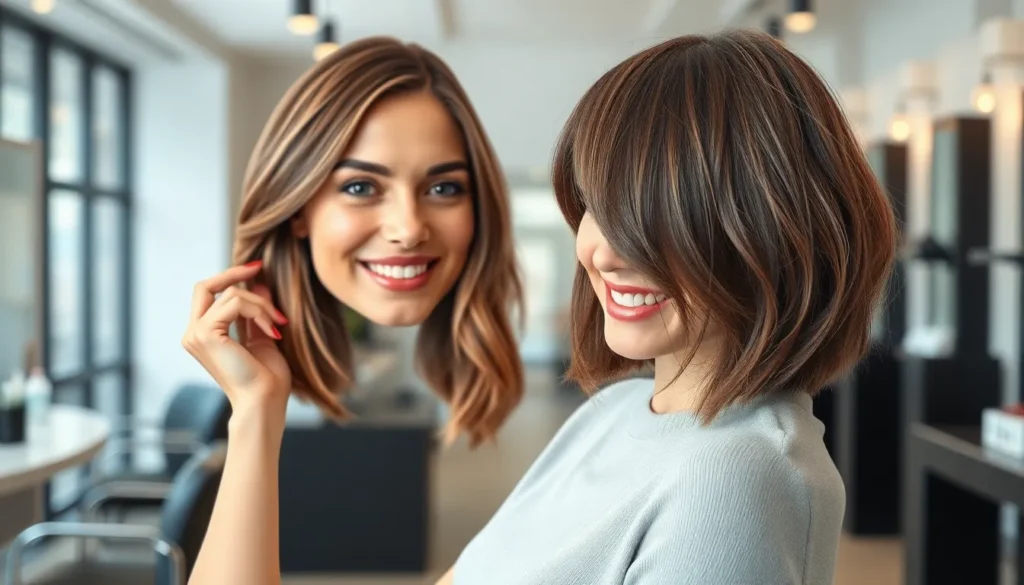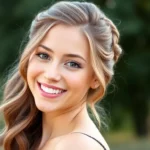We’ve all been there – scrolling through countless hairstyle photos wondering which cut will perfectly frame our face and match our lifestyle. The bob with side bangs consistently emerges as a timeless winner that’s captured hearts across generations and continues to dominate salon requests worldwide.
This isn’t just another trendy haircut that’ll leave you with regret in six months. The bob with side bangs offers the perfect blend of sophistication and playfulness while working beautifully with virtually every face shape and hair texture. Whether you’re aiming for a sleek professional look or something more relaxed and bohemian this versatile style adapts to your needs.
We’re diving deep into everything you need to know about this game-changing hairstyle – from choosing the right variation for your features to styling tips that’ll keep you looking effortlessly chic every single day.
Classic Bob With Side Bangs: The Timeless Foundation
Building upon the versatile foundation we’ve established, the classic bob with side bangs represents the most enduring variation of this beloved hairstyle.
Traditional Chin-Length Bob Structure
Chin-length bobs create the perfect canvas for side bangs by establishing clean lines and balanced proportions. We recommend maintaining the length between the jawline and chin for optimal versatility. The blunt cut technique works best for thick hair types, while textured ends soften the look for fine hair. Layering should remain minimal to preserve the bob’s signature geometric shape.
Precision cutting ensures the classic bob maintains its structured appearance throughout different styling sessions. Professional stylists typically use a 0-degree elevation when creating this foundation cut. The perimeter should fall evenly around the head, creating that iconic rounded silhouette. Weight distribution becomes crucial for achieving the proper swing and movement that makes this style so recognizable.
Optimal Side Bang Length and Angle
Eyebrow-skimming bangs offer the most flattering length for classic bob structures. We suggest keeping the longest pieces at eyebrow level while the shortest sections graze the temples. The angle should sweep diagonally from the deeper part toward the shorter side, creating natural movement. Cutting bangs too short can disrupt the harmony between the bob length and facial framing elements.
Professional cutting techniques involve creating a soft diagonal line rather than harsh geometric angles. Point cutting or slide cutting methods help achieve that effortless, lived-in texture. The transition from bang to bob should appear seamless, with longer pieces blending into the overall length. Most stylists recommend starting longer and gradually adjusting the angle during the cutting process.
Face Shapes That Benefit Most
| Face Shape | Why It Works | Styling Tips |
|---|---|---|
| Round faces | Adds angular definition | Keep bangs longer on one side |
| Square faces | Softens strong jawlines | Sweep bangs toward temples |
| Heart shaped | Balances wider foreheads | Maintain fullness at chin level |
| Oval faces | Complements natural proportions | Experiment with bang thickness |
Round faces gain instant structure from the combination of chin-length bobs and sweeping side bangs. We’ve observed that this pairing creates vertical lines that elongate the face while the side part adds asymmetry. The bang angle should point toward the temples to draw attention away from fuller cheeks. Keeping some length in the bangs prevents the face from appearing too wide.
Square faces benefit from the softening effect that side-swept bangs provide to angular features. The curved line of the bob works against sharp jawlines, while bangs add gentle movement around the forehead. We recommend avoiding blunt bangs with square faces, as they can emphasize width. Instead, longer pieces that graze the cheekbones create the most flattering frame.
Textured Bob With Side Bangs: Adding Movement and Volume

Textured bobs with side bangs create ever-changing dimension that transforms flat hair into a voluminous masterpiece. This elevated variation adds contemporary flair to the classic style we’ve explored.
Layered Cutting Techniques
Point cutting creates the foundation for textured bobs by removing weight while maintaining length throughout the hair shaft. Professional stylists use this technique to add natural movement that works harmoniously with side bangs. Razor cutting produces softer, more organic edges that blend seamlessly from the crown to the nape area.
Choppy layers positioned strategically around the face frame side bangs beautifully while adding fullness to fine hair types. These layers should graduate from shorter pieces near the ears to longer sections at the back. Internal layering removes bulk without sacrificing the bob’s overall shape or compromising the side bang integration.
Texturizing shears create micro layers that enhance natural hair movement without creating obvious disconnection. Stylists typically focus these cuts around the perimeter and through the mid lengths. Slide cutting techniques add subtle graduation that prevents the heavy line often associated with traditional bobs.
Styling Products for Enhanced Texture
Volumizing mousses applied to damp hair before blow drying create lift at the roots while maintaining side bang placement. We recommend using products containing polymers that expand when heated. Sea salt sprays enhance natural texture patterns and work particularly well on wavy hair types seeking enhanced definition.
Texturizing pastes provide piecey separation that emphasizes individual layers without weighing down fine hair. These products typically contain waxes that add grip and hold throughout the day. Root lifting sprays target the crown area where textured bobs need maximum volume support.
Dry shampoos serve dual purposes by absorbing excess oil while adding gritty texture that enhances layered cuts. Focus application on the roots and mid lengths rather than the ends. Light hold hairsprays lock in texture without creating stiffness that compromises the bob’s natural movement.
Daily Maintenance Requirements
Morning styling takes approximately 10 to 15 minutes using a round brush and blow dryer to enhance the textured layers. Start with side bangs first to establish their direction before moving to the bob’s body. Scrunching techniques work well for improving natural waves within the layered structure.
Weekly deep conditioning treatments prevent textured cuts from appearing frizzy or damaged due to the increased surface area created by layering. Focus treatments on mid lengths and ends while avoiding the root area. Regular trimming every 6 to 8 weeks maintains the textured bob’s shape and prevents split ends from traveling up the hair shaft.
Overnight protection using silk pillowcases or loose braids preserves the textured style while preventing side bangs from flattening against the face. Sleep with hair slightly elevated using a silk scarf wrapped loosely around the crown area. Touch up styling between washes involves refreshing side bangs with a small round brush and quick blast of cool air from the dryer.
Asymmetrical Bob With Side Bangs: Creating Modern Edge
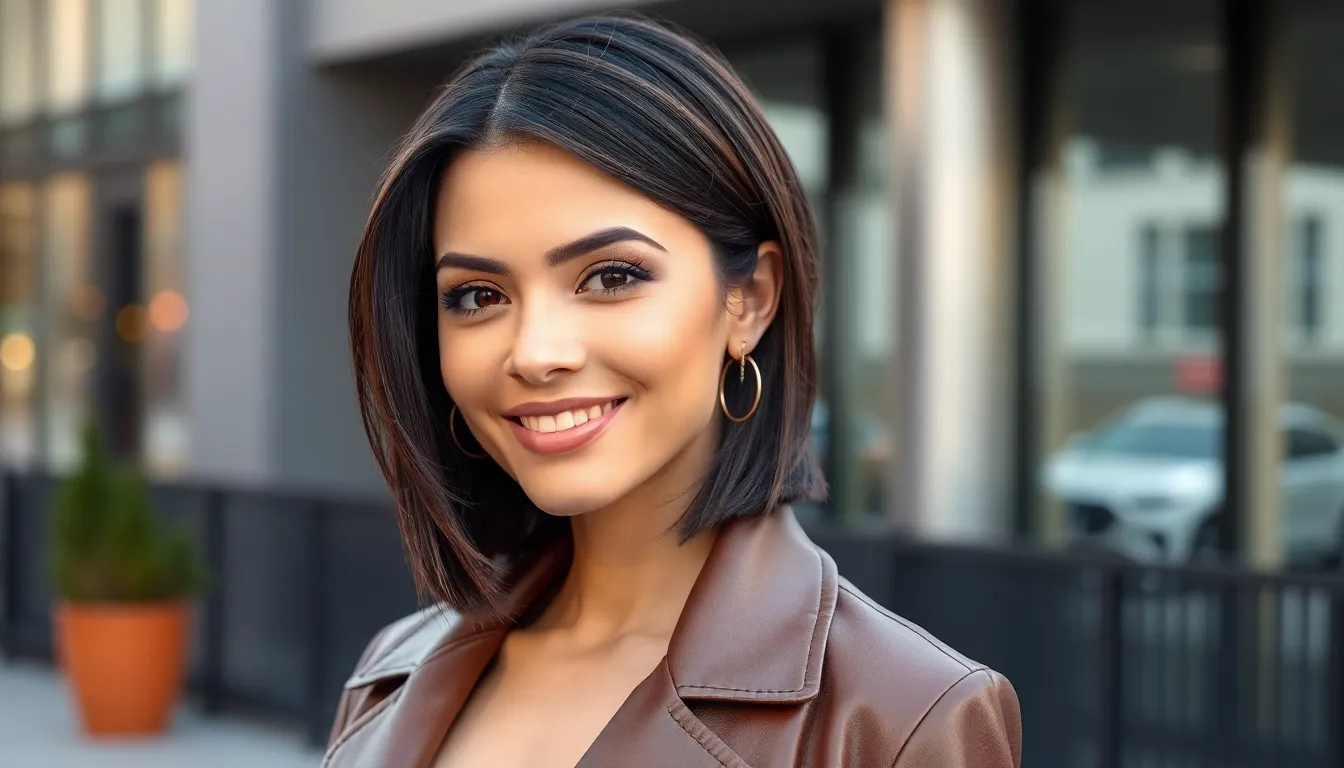
The asymmetrical bob with side bangs delivers contemporary sophistication that turns heads wherever you go. This cutting-edge variation breaks traditional symmetry rules while maintaining the polished elegance bob styles are known for.
Longer Front Sections
Creating longer front sections transforms your bob into an architectural masterpiece that frames your face beautifully. We recommend keeping the front pieces 2-3 inches longer than the back to achieve the perfect asymmetrical balance. The extended length draws attention to your best features while creating visual interest that photographs wonderfully from every angle.
This technique works exceptionally well with side bangs because the longer front pieces create a natural flow that seamlessly connects with your bang line. Your stylist should cut the front sections at a sharp angle, starting from the shortest point at the nape and gradually increasing length toward your face. Fine hair benefits tremendously from this approach as the varied lengths add perceived thickness and body.
Strategic layering within the longer front sections prevents the hair from appearing heavy or overwhelming. Internal layers create movement while maintaining the bob’s structural integrity, ensuring your style looks intentional rather than accidental.
Dramatic Side Part Placement
Positioning your side part creates the foundation for an eye-catching asymmetrical bob that complements your side bangs perfectly. We suggest placing the part 2-3 inches off center rather than creating an extreme side part that might overwhelm your features. This placement allows your side bangs to fall naturally while creating the dramatic asymmetry you’re seeking.
The deeper side part works harmoniously with longer front sections to enhance the bob’s modern appeal. Your part should align with the outer corner of one eyebrow, creating a natural guide for your styling routine. This positioning ensures consistency each time you style your hair at home.
Switching your part occasionally prevents your hair from developing permanent indentations while maintaining the style’s versatility. But, keeping the part on the same side 80% of the time allows your hair to naturally fall into place with minimal effort.
Professional Styling Tips
Professional styling techniques elevate your asymmetrical bob with side bangs from good to absolutely stunning. Start with damp hair and apply a volumizing mousse to your roots, focusing on the crown area where you’ll create the most lift. We recommend using a round brush while blow drying, pulling the longer front sections downward to emphasize the asymmetrical shape.
Your side bangs require special attention during the styling process to maintain their swept appearance. Use a small round brush to curve the bangs away from your face while directing airflow downward to create smoothness. A light coating of smoothing serum prevents frizz without weighing down the delicate bang area.
Finishing with a flat iron adds sleekness and definition to the cut lines, particularly important for maintaining the sharp angles of your asymmetrical bob. Focus on the ends and the transition points between different lengths to create clean, professional results that last throughout your day.
Wavy Bob With Side Bangs: Embracing Natural Texture
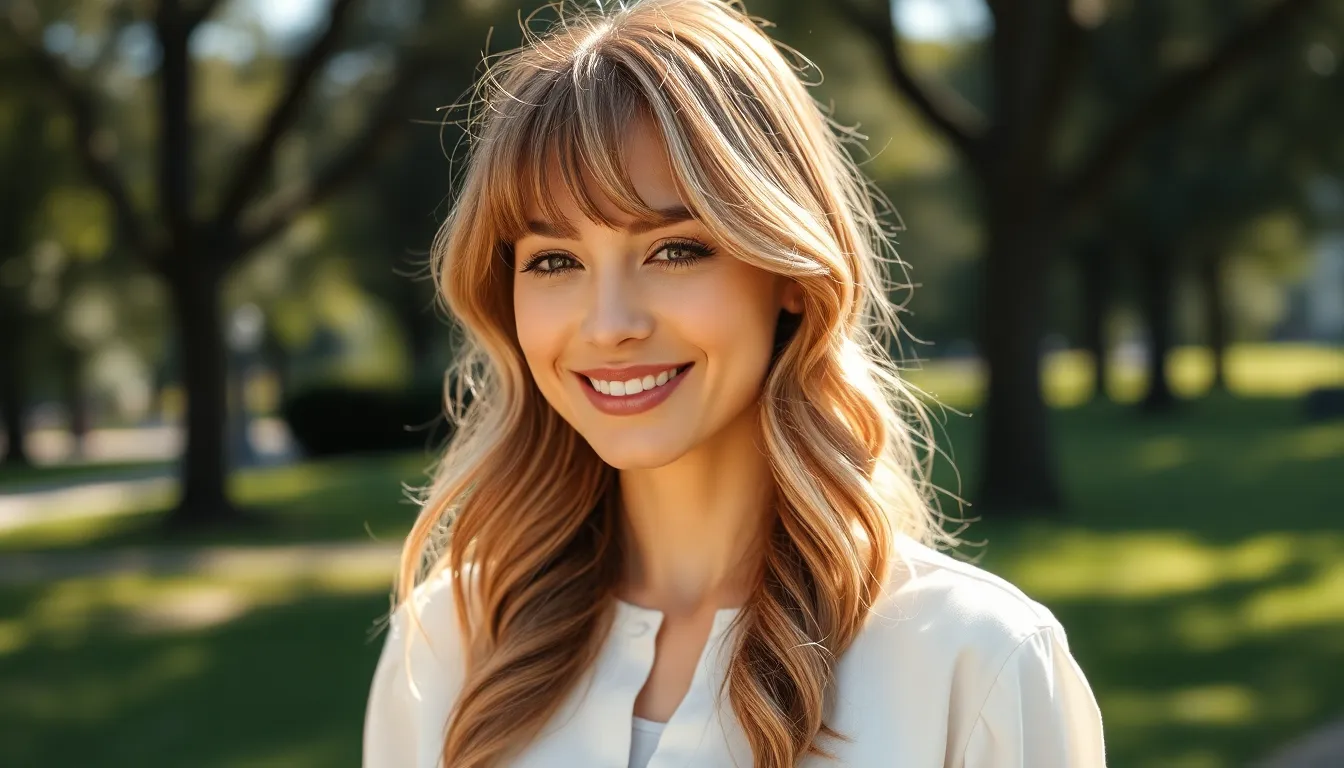
Wavy hair brings effortless movement to the bob with side bangs combination, creating a relaxed sophistication that works beautifully for everyday wear. Natural texture eliminates the need for extensive styling while maintaining the polished appeal that makes this cut so versatile.
Improving Natural Wave Patterns
Working with your natural wave pattern creates the most authentic and sustainable wavy bob with side bangs. Identifying your exact wave type helps determine the best cutting approach, with loose waves benefiting from weight removal at the ends while tighter waves need strategic layering throughout the mid lengths. Professional stylists recommend cutting wavy hair when slightly damp to see how each section naturally falls and springs back.
Layer placement becomes crucial for wavy bobs, as internal layers prevent the triangular shape that often occurs with naturally textured hair. We suggest asking for point cutting techniques that follow your natural wave direction, creating seamless integration between the bob structure and side swept bangs. Face framing layers work particularly well with wavy texture, softening the overall silhouette while maintaining the bob’s signature shape.
Side bang placement requires special consideration with wavy hair, as the natural movement can cause sections to separate unpredictably. Cutting side bangs slightly longer than desired allows for natural shrinkage when waves dry, preventing them from appearing too short or choppy. The ideal length grazes the eyebrow area when hair is completely dry and styled naturally.
Heat-Free Styling Methods
Scrunching techniques maximize natural wave definition without damaging heat tools or disrupting your hair’s natural curl pattern. Start with damp hair and apply styling products section by section, then scrunch upward from ends to roots to encourage wave formation. This method works exceptionally well for maintaining the side bang shape while improving overall texture.
Plopping offers another effective heat free approach that reduces frizz while defining waves throughout your bob. Use a microfiber towel or cotton t shirt to wrap wet hair after applying products, leaving it wrapped for 15 to 20 minutes before air drying. This technique prevents disruption of the wave pattern while maintaining volume at the roots.
Braiding damp hair creates uniform waves that complement the structured nature of bob cuts while keeping side bangs smooth and controlled. We recommend loose three strand braids or rope braids for subtle wave enhancement, removing them when hair reaches about 80% dryness. This method ensures consistent texture throughout the bob while preserving the side bang’s intended direction.
Diffusing on low heat settings provides faster drying while maintaining natural texture, making it an ideal compromise between air drying and traditional blow drying. Use a diffuser attachment with medium airflow and low temperature, cupping sections of hair and lifting toward the scalp to encourage volume and definition.
Product Recommendations for Wave Definition
| Product Type | Benefits | Application Method |
|---|---|---|
| Leave-in conditioner | Moisture retention, frizz control | Apply to damp hair from mid-length to ends |
| Wave improving cream | Definition without crunch | Distribute evenly through damp hair |
| Sea salt spray | Texture and hold | Mist onto damp or dry hair, scrunch |
| Curl defining gel | Strong hold, prevents frizz | Rake through wet hair sections |
Lightweight mousses provide volume and definition without weighing down wavy bob textures or causing side bangs to appear greasy. Apply mouse to damp hair focusing on the roots and mid lengths, avoiding the ends to prevent stiffness. This product type works particularly well for fine wavy hair that needs extra body and movement.
Wave creams offer the perfect balance of moisture and hold for medium to coarse wavy hair textures in bob cuts. These products define individual waves while preventing frizz and maintaining flexibility throughout the day. Apply wave cream using the praying hands method, smoothing from roots to ends before scrunching.
Oil based serums seal moisture and add shine to wavy bobs without disrupting the natural texture or creating unwanted buildup. Use sparingly on the ends and mid lengths, avoiding the root area and side bang sections to prevent greasiness. Argan oil and jojoba oil work exceptionally well for this hair type and length.
Short Bob With Side Bangs: Maximizing Minimal Length
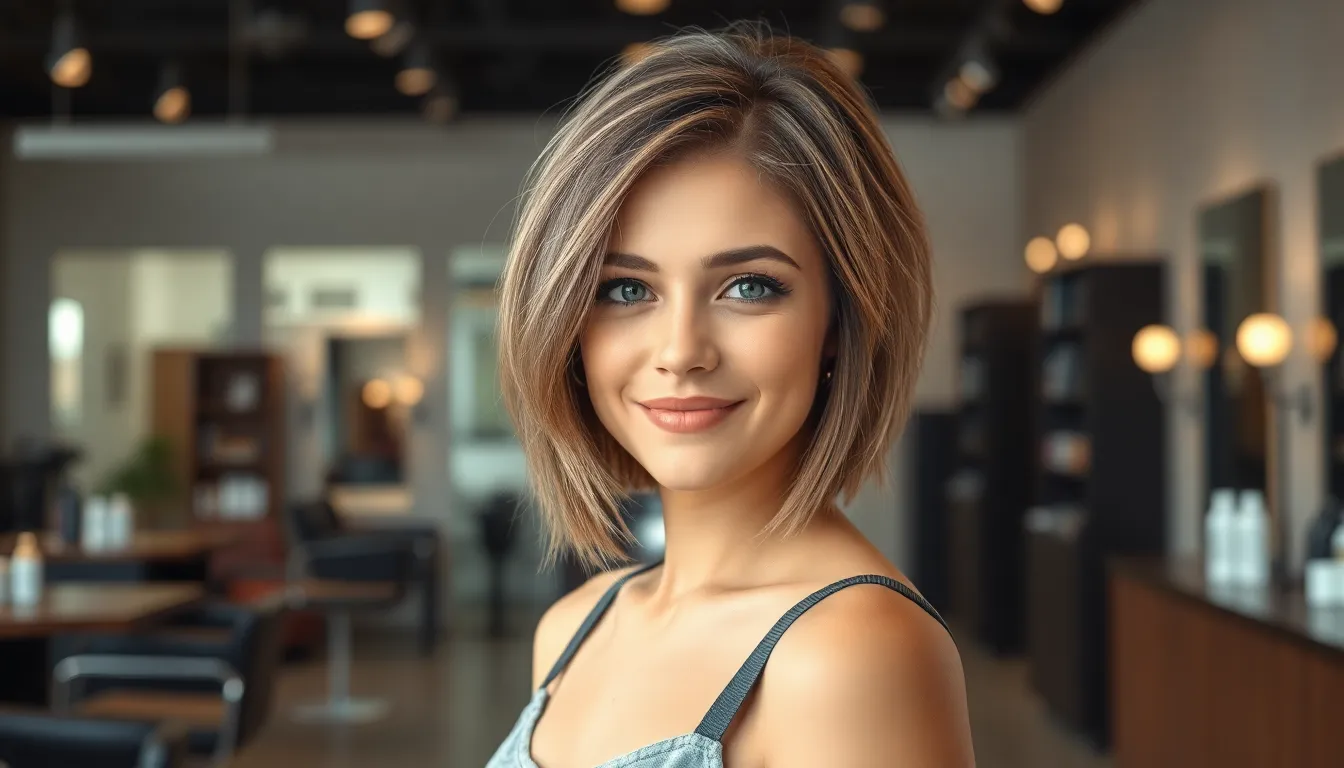
Short bob cuts with side bangs prove that less length doesn’t mean compromising on style impact. We’ll show you how strategic cutting and styling techniques can create maximum visual appeal with minimal hair length.
Pixie-Bob Hybrid Styles
Pixie bob combinations blend the edginess of a pixie cut with the classic appeal of a bob structure. We recommend keeping the back section cropped close to the nape while maintaining 2 to 3 inches of length through the crown and sides. This creates a graduated silhouette that frames your face beautifully.
Textured layers throughout the pixie bob add crucial volume and movement to shorter lengths. Point cutting techniques work exceptionally well for this style, creating soft edges that prevent the cut from looking too harsh. We suggest asking your stylist to use thinning shears sparingly to maintain density while removing bulk.
Side swept elements in pixie bob hybrids require precise placement to complement the shorter overall length. Position the longest pieces of your side bangs at temple level, allowing them to blend seamlessly into the longer side sections. This creates a continuous flow that elongates your face shape naturally.
Side Bang Proportions for Short Hair
Proportional balance becomes critical when working with shorter bob lengths and side bangs. We recommend keeping side bangs between 1.5 to 2 inches in width to avoid overwhelming your facial features. Narrow faces benefit from wider bang sections, while broader faces look best with more concentrated fringe areas.
Length ratios should follow the one third rule for optimal visual appeal. Position your side bangs to fall approximately one third of the way down from your hairline to your eyebrows. This creates natural eye emphasis without creating harsh lines across your forehead.
Density considerations matter significantly more in shorter bob styles because every strand counts toward the overall shape. We suggest maintaining 60 to 70 percent of your natural bang density to create soft movement while ensuring adequate coverage. Thinning out side bangs too much can make short bobs appear sparse and unfinished.
Growing Out Strategies
Gradual length addition helps maintain your bob’s integrity during the growing out process. We recommend scheduling trims every 6 to 8 weeks to clean up the back sections while allowing the front pieces to gain length. This prevents that awkward mullet phase that many people experience.
Strategic layering during the transition period keeps your short bob looking intentional rather than neglected. Add subtle layers around the perimeter to create movement and prevent the blunt line from becoming too severe as hair grows. Focus on maintaining the side bang length until the rest catches up.
Styling adaptations become essential tools for managing growing short bobs with side bangs. Use texturizing sprays to add grip and hold to shorter sections that might stick out awkwardly. We find that small amounts of pomade or styling cream help piece out layers naturally while controlling any rebellious strands during the growing out phase.
Long Bob With Side Bangs: Versatile Shoulder-Length Style

Long bobs with side bangs offer the perfect compromise between short and long hair, providing endless styling possibilities for shoulder-length cuts. This sophisticated style maintains enough length for updos while delivering the fresh, modern appeal of shorter cuts.
Lob Cutting Guidelines
Optimal length positioning falls between the collarbone and shoulders for the most flattering proportions. We recommend cutting the back section first, creating a straight baseline that serves as your foundation for the entire style. Professional stylists typically use point cutting techniques around the perimeter to soften harsh lines and add subtle movement.
Side bang placement requires precise measurement to complement the lob’s proportions perfectly. Position the bangs to start approximately 2 inches from your natural part line, sweeping across the forehead to hit just below the brow bone. Layering within the side bangs creates dimension and prevents them from appearing too heavy against the longer bob length.
Face framing layers enhance the lob’s versatility by adding movement around the jawline and cheekbones. Cut these layers to start 1-2 inches below the chin, gradually blending into the main length. Internal layering throughout the mid-lengths prevents the style from appearing too blunt while maintaining the bob’s structured silhouette.
Multiple Styling Options
Sleek and straight styling showcases the lob’s clean lines using a flat iron and smoothing serum for a polished finish. Apply heat protectant spray before blow drying with a paddle brush, then seal the cuticles with a ceramic flat iron set to 350°F. This classic approach works perfectly for professional settings and formal occasions.
Beachy waves transform the lob into a relaxed, effortless look using texturizing sprays and scrunching techniques. Spray damp hair with sea salt spray, scrunch sections upward, and air dry or diffuse on low heat. The combination of loose waves and side-swept bangs creates an ideal weekend style that requires minimal maintenance.
Half-up styles maximize the lob’s length while keeping hair away from the face during active days. Gather the top section from temple to temple, securing with a small elastic or decorative clip. Leave the side bangs loose to frame your face, creating an elegant balance between polished and casual.
Braided accents add interest without requiring extensive length for complex styles. Create small side braids along the hairline, French braid the side bang section, or add a simple three-strand braid as an accent piece. These details work particularly well for special occasions or when you want to elevate your everyday lob.
Transitioning From Longer Hair
Gradual trimming approaches minimize shock when transitioning from long hair to a shoulder-length lob. Schedule appointments every 4-6 weeks, removing 2-3 inches each visit until you reach your desired length. This method allows you to adjust to shorter lengths while maintaining healthy ends throughout the process.
Layering strategies help redistribute weight as you transition to the lob’s structure. Start by adding long layers throughout the mid-lengths, then gradually shorten the overall length while refining the layer placement. Internal texturizing removes bulk without compromising the style’s integrity, making the transition feel more natural.
Styling product adjustments become necessary as your hair reaches shoulder length, since longer hair typically requires different formulations. Switch from heavy creams to lightweight mousses, reduce the amount of oil-based products, and incorporate volumizing sprays to maintain body and movement. The shorter length means products have more immediate impact on your hair’s appearance and texture.
Styling Techniques for Bob With Side Bangs
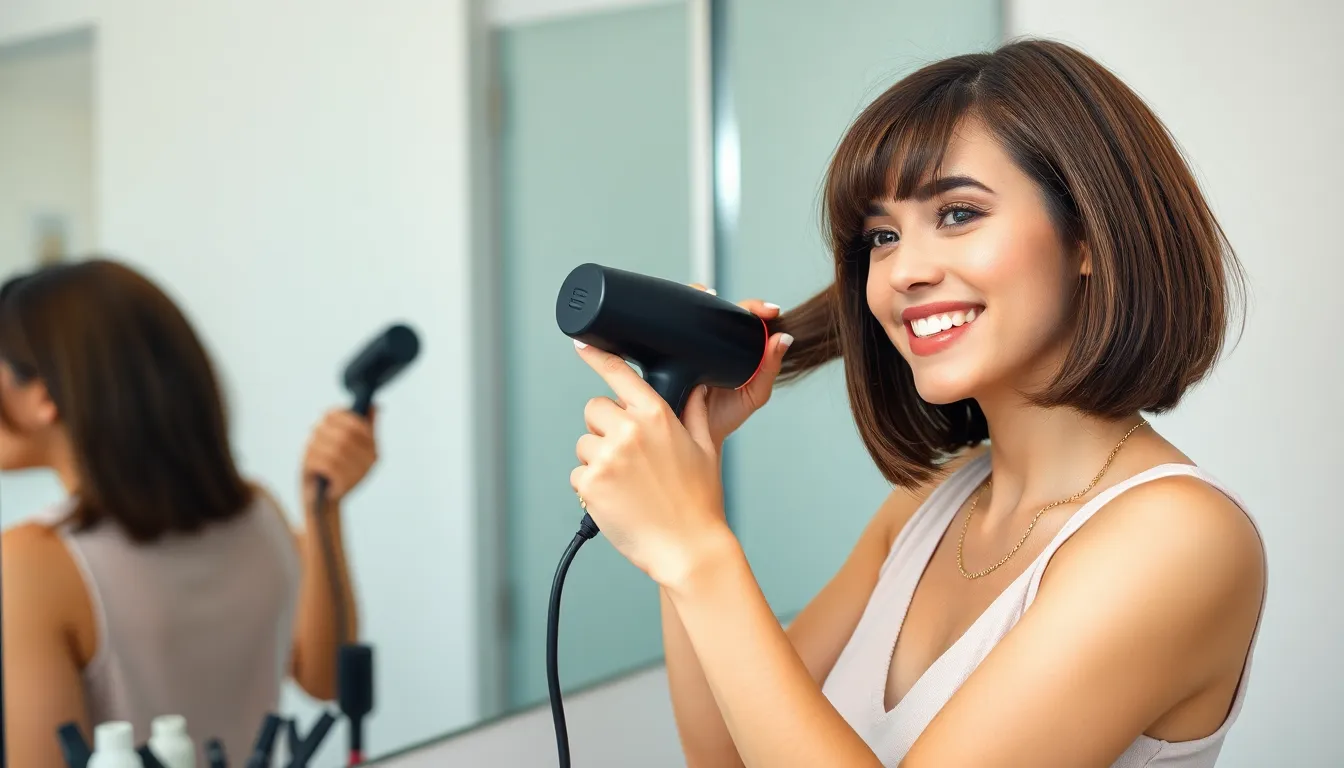
Mastering the right styling techniques transforms your bob with side bangs from a simple haircut into a polished, versatile look that works for any occasion.
Blow-Drying Methods
Start with damp hair and apply a heat protectant spray throughout your strands and side bangs. We recommend using a volumizing mousse at the roots to create lift and body from the foundation up.
Section your hair into three layers – bottom, middle, and top – for more manageable styling. Begin blow drying the bottom section using a round brush, wrapping small sections around the barrel and pulling downward to create smoothness.
Direct the airflow from roots to ends to seal the hair cuticle and reduce frizz. For side bangs specifically, use a small round brush and roll them under slightly while directing the blow dryer downward at a 45 degree angle.
Create volume at the crown by lifting sections with your round brush and directing heat underneath for 3-5 seconds. This technique prevents your bob from looking flat against your head.
Finish with a blast of cool air to set your style and add shine. The cool shot button on your blow dryer locks in the shape you’ve created and extends your style’s longevity.
Heat Tool Usage and Protection
Apply thermal protection products before using any heated styling tools to prevent damage and maintain healthy hair. We suggest using products with heat protection up to 450°F for optimal safety.
Set your flat iron between 300-350°F for fine hair and 350-400°F for thick or coarse hair types. Higher temperatures aren’t always better and can cause unnecessary damage to your bob’s delicate structure.
Use your flat iron in single passes rather than repeatedly going over the same section. Start at the roots of each section and glide smoothly to the ends in one fluid motion.
Style side bangs with a small barrel curling iron heated to 300°F maximum. Wrap bangs around the barrel for 5-8 seconds, then release and gently finger comb for a natural sweep.
Clean your heat tools regularly with a damp cloth to remove product buildup that can cause uneven heating. This maintenance step ensures consistent results every time you style your bob.
Invest in quality tools with ceramic or titanium plates that distribute heat evenly and reduce hot spots. Professional grade tools often provide better temperature control and longer lasting results.
Creating Different Looks Throughout the Week
Monday calls for sleek sophistication using a flat iron to create pin straight strands and perfectly positioned side bangs. Apply a smoothing serum before styling and finish with a light hairspray for office ready polish.
Tuesday brings textured waves created by braiding damp hair overnight or using a 1.5 inch curling iron on dry hair. Scrunch your waves gently with your fingers and use a texturizing spray for piece separation.
Wednesday works perfectly for the half up style where you gather the top section above your ears and secure with a small elastic or bobby pins. Leave your side bangs loose to frame your face naturally.
Thursday transforms into beach wave day using sea salt spray on damp hair and scrunching while air drying. This effortless look pairs beautifully with your bob’s natural movement and side bang texture.
Friday evening calls for glamorous volume achieved by teasing the crown section gently and smoothing the top layer over the teased area. Use a volumizing spray and finish with flexible hold hairspray.
Weekend styling embraces your natural texture with minimal product and air drying for a relaxed, undone look. Apply leave in conditioner to damp hair and scrunch lightly for enhanced natural waves.
Sunday reset involves deep conditioning treatments to prepare your bob for another week of styling. Use a protein mask if your hair feels weak or a moisture mask if it appears dry or frizzy.
Maintenance Tips for Bob With Side Bangs
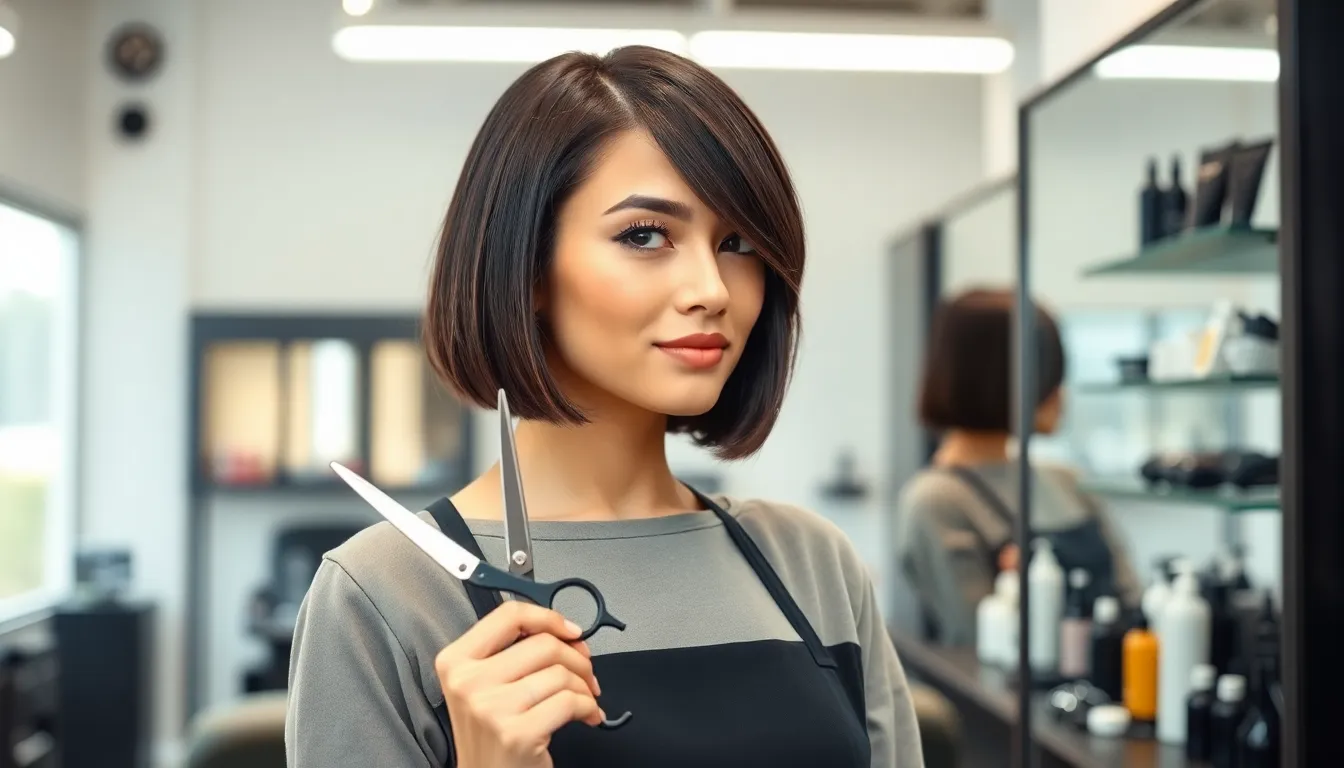
Proper maintenance keeps your bob with side bangs looking fresh and professionally styled between salon visits. These essential care routines help preserve your cut’s shape and ensure your side bangs frame your face beautifully.
Regular Trim Schedules
Bob maintenance requires trimming every 4-6 weeks to maintain the precise shape and prevent split ends. Side bangs grow faster than the rest of your hair and need attention every 2-3 weeks to keep their optimal length and angle.
Schedule your appointments based on hair growth rate and lifestyle demands. Fine hair typically needs more frequent trims every 4 weeks while thicker hair can wait 6-8 weeks between cuts.
Book bang trims separately from full haircuts to maintain budget flexibility and timing convenience. Most salons offer quick bang touch ups for $15-25 which takes only 10-15 minutes.
Mark your calendar with exact maintenance dates rather than waiting until your style looks grown out. Consistent scheduling prevents the awkward in between stages that require more extensive reshaping.
At-Home Touch-Up Techniques
Invest in quality hair cutting scissors designed specifically for bangs rather than using household scissors. Professional shears create clean cuts that blend seamlessly with your existing style.
Trim side bangs when hair is completely dry and styled in its natural position. Wet hair appears longer and can lead to cutting too much length accidentally.
Use the point cutting technique by holding scissors vertically and making small snips into the hair ends. This method creates softer edges that blend naturally with professionally cut sections.
Focus on removing only the longest pieces that fall below your desired bang line. Cut conservatively in small sections working from the center outward toward the corners.
Practice the twist and snip method for emergency touch ups by twisting small sections of overgrown bangs and cutting at an angle. This technique prevents blunt lines that look obviously self cut.
Professional Salon Visits
Choose a stylist experienced with bob cuts and bang maintenance who understands the technical precision required for these styles. Look for portfolios showcasing similar cuts and face shapes.
Communicate your daily styling routine and maintenance preferences during consultation appointments. Share photos of your favorite looks and discuss realistic upkeep expectations.
Request exact cutting techniques such as point cutting for softer edges or razor cutting for added texture. Different methods achieve varying levels of movement and maintenance requirements.
Ask your stylist to demonstrate styling techniques during your appointment so you can replicate the look at home. Take notes on product application amounts and brush techniques.
Schedule color services strategically around your cutting appointments to maximize salon visit efficiency. Plan highlights or color refreshes 1-2 weeks before major cuts to allow for adjustment periods.
Discuss seasonal adjustments to your bob and bang style based on weather conditions and lifestyle changes. Summer cuts might need more layers while winter styles can be slightly longer for versatility.
Celebrity Inspiration: Famous Bob With Side Bangs Looks

Looking to top A-list hairstylists and red carpet moments provides endless inspiration for perfecting your own bob with side bangs. We’ve analyzed celebrity styles that showcase the versatility and elegance of this timeless cut.
Red Carpet Variations
Taylor Swift’s Sleek Golden Globe Bob demonstrates how precision cutting creates show-stopping impact on formal occasions. Her chin-length bob featured perfectly straight side bangs swept dramatically to one side, creating an angular frame that emphasized her cheekbones. We noticed how her stylist used a flat iron technique to achieve mirror-like smoothness, while the side bangs maintained their shape throughout the evening.
Emma Stone’s Textured Awards Season Look showcases how subtle layering transforms a classic bob into red carpet glamour. Her shoulder-grazing lob incorporated piecey side bangs that blended seamlessly with face-framing layers. Strategic use of texturizing spray created movement that caught camera flashes beautifully, proving that textured bobs work exceptionally well for formal events.
Charlize Theron’s Asymmetrical Premiere Style revolutionized traditional bob expectations with its avant-garde silhouette. Her dramatically angled cut featured longer front sections paired with wispy side bangs, creating an architectural look that photographers loved. This sophisticated variation proves that asymmetrical bobs with side bangs can command attention at the most prestigious events.
Everyday Street Style Adaptations
Reese Witherspoon’s Casual Coffee Run Bob exemplifies effortless everyday styling that looks polished without appearing overdone. Her slightly tousled bob with side-swept bangs demonstrated how scrunching products can create natural texture for daily wear. We admire how she maintains the bob’s structure while allowing for lived-in movement that works for busy mom life.
Jennifer Lawrence’s Off-Duty Wavy Style showcases how natural texture elevates casual bob styling. Her air-dried waves paired with long side bangs created a relaxed sophistication perfect for running errands or casual outings. This approach proves that embracing your natural wave pattern can make everyday styling both easier and more interesting.
Scarlett Johansson’s Shopping Trip Look demonstrates how minimal styling can maximize impact for daily activities. Her straight bob with blunt side bangs required only a quick blow-dry and smoothing serum to achieve a chic appearance. This streamlined approach shows that bob maintenance doesn’t need to be time-consuming for everyday elegance.
Trendsetting Modifications
Zendaya’s Color-Blocked Bob Innovation introduced unexpected color placement that redefined traditional bob boundaries. Her honey-toned highlights concentrated through the side bangs created dimensional contrast against darker base tones. This technique proves that strategic color placement can make side bangs the focal point of the entire hairstyle.
Margot Robbie’s Micro-Bang Fusion combined ultra-short fringe elements with traditional side bangs for a hybrid approach that influenced countless copycat styles. Her precision-cut micro bangs transitioned into longer side-swept sections, creating multiple styling possibilities within one cut. We’ve seen this technique become increasingly popular among younger demographics seeking unique bob variations.
Lupita Nyong’o’s Textural Contrast Bob demonstrated how different textures within one hairstyle can create striking visual interest. Her sleek bob body contrasted beautifully with purposefully tousled side bangs, proving that mixing smooth and textured elements adds depth to celebrity-inspired looks. This innovative approach shows that bobs with side bangs can incorporate multiple styling techniques for maximum impact.
Conclusion
We’ve explored the incredible versatility of the bob with side bangs and its ability to transform your look while remaining effortlessly chic. From classic cuts to modern asymmetrical styles this hairstyle continues to prove why it’s remained a favorite among celebrities and everyday style enthusiasts alike.
The beauty lies in finding the perfect variation that complements your face shape hair texture and lifestyle. Whether you choose a textured lob or a sleek short bob the right styling techniques and maintenance routine will keep your look fresh and polished.
With proper care regular trims and the styling methods we’ve covered you’ll have a hairstyle that adapts to any occasion. The bob with side bangs isn’t just a cut—it’s a foundation for endless styling possibilities that grows more beautiful with time.
Frequently Asked Questions
What face shapes work best with a bob and side bangs?
A bob with side bangs is incredibly versatile and flatters most face shapes. Round faces benefit from the angular definition created by chin-length bobs and sweeping side bangs. Square faces are softened by the gentle movement of side-swept bangs. Heart-shaped faces find perfect balance with this combination, while oval faces can experiment with different bang thicknesses to customize their look.
How often should I trim my bob and side bangs?
Regular maintenance is crucial for keeping your bob looking fresh. Schedule bob trims every 4-6 weeks to maintain the shape and structure. Side bangs require more frequent attention, needing trims every 2-3 weeks to prevent them from growing too long and losing their flattering angle. This schedule ensures your style always looks polished and intentional.
What’s the difference between a textured bob and a classic bob?
A classic bob features clean, precise lines with a structured appearance that creates a timeless, sophisticated look. A textured bob incorporates layers, point cutting, or razor cutting techniques to add movement and volume. The textured version is ideal for fine hair or those wanting a more casual, lived-in appearance with natural-looking movement and dimension.
Can I style my wavy bob with side bangs without heat?
Absolutely! Wavy bobs respond beautifully to heat-free styling methods. Try scrunching damp hair with a microfiber towel, using the plopping technique with a cotton t-shirt, or braiding slightly damp hair overnight for enhanced wave definition. These methods work with your natural texture while preventing heat damage and maintaining healthy hair.
What products work best for maintaining a bob with side bangs?
Essential products include volumizing mousse for lift at the roots, heat protectant spray before styling, and lightweight texturizing products for movement. For wavy textures, use leave-in conditioners and wave-enhancing creams. Fine hair benefits from sea salt sprays, while thicker hair may need smoothing serums. Weekly deep conditioning treatments help maintain hair health and manageability.
How do I grow out my bob while keeping it stylish?
Growing out a bob requires strategic maintenance and styling adaptations. Schedule regular trims to remove bulk and maintain shape while gradually increasing length. Add layers to prevent a triangular silhouette and use texturizing products to manage the in-between stages. Consider transitioning through different bob lengths (short to regular to long bob) for a more controlled growing process.

